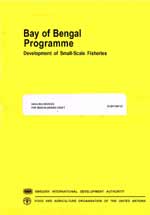
WORKING PAPERS - BOBP/WP/51
Hauling Devices For Beachlanding Craft
by
A. Overa
Fishing Craft Engineer, Bay of Bengal Programme
P.A. Hemminghyth
Marine Engineer (Associate Professional Officer)
Bay of Bengal Programme
 |
WORKING PAPERS - BOBP/WP/51 Hauling Devices For Beachlanding Craftby |
|
Executing Agency: FOOD AND AGRICULTURE ORGANIZATION OF THE UNITED NATIONS Funding Agency: SWEDISH INTERNATIONAL DEVELOPMENT AUTHORITY Development of Small-Scale Fisheries in the Bay of Bengal. Madras, India, August 1986 |
| The designations employed and the presentation of material in this publication do not imply the expression of any opinion whatsoever on the part of the Food and Agriculture Organization of the United Nations concerning the legal status of any country, territory, city or area or of its authorities, or concerning the delimitation of its frontiers or boundaries. |
All rights reserved. Reproduction and dissemination of material in this information product for educational or other non-commercial purposes are authorized without any prior written permission from the copyright holders provided the source is fully acknowledged. Reproduction of material in this information product for resale or other commercial purposes is prohibited without written permission of the copyright holders. Applications for such permission should be addressed to the Chief, Publishing and Multimedia Service, Information Division, FAO, Viale delle Terme di Caracalla, 00100 Rome, Italy or by email to [email protected]
© FAO 2004
|
This paper describes mechanical hauling devices for beachcraft developed and tested by the small-scale fisheries project of the Bay of Bengal Programme (BOBP) in India and Sri Lanka. The paper records the project’s experiences with beach-hauling devices from 1980 till 1985. A diesel engine-driven winch capable of hauling boats up to a weight of about 1500 kg was introduced and is now manufactured commercially. A problem that still awaits solution is that of suitable rollers underneath the hull to reduce friction drag. The trials have shown that for larger craft and rough conditions, more complicated multi-speed winches are required. Besides the authors, those who took part in the work included Mr. Oyvind Gulbrandsen, Naval Architect (Consultant), who designed and tested the manually operated capitan Mr. R. Ravikumar, Naval Architect; Mr. S.O. Johansen, BOBP Naval Architect(Associate Professional Officer); Mr. S.B. Sarma, Inspector of Fisheries, Andhra Pradesh; and Mr. E. Srinivasan, Inspector of Fisheries, Tamil Nadu Numerous fishermen also participated in the trials. The work on beachhauling devices, and this paper describing the work, were sponsored by the small-scale fisheries project of the BOBP. The project is funded by SIDA (Swedish International Development Authority) and executed by FAQ (Food and Agriculture Organization of the United Nations), and covers five countries bordering the Bay of Bengal — Bangladesh, India, Malaysia, Sri Lanka and Thailand. The main goals of the project are to develop, demonstrate and promote appropriate technologies and methodologies to improve the conditions of small-scale fisherfolk in member countries. |
PREFACE
1. INTRODUCTION
2. MANUAL HAULING DEVICES
3. AN ENGINE-DRIVEN WINCH
4. BEACH ROLLERS
5. POWER REQUIREMENT
6. HAULING AND LAUNCHING TECHNIQUE
7. DISCUSSION
8. BEACH HAULING DEVICES IN PICTURES
FIGURES
1. Diesel Engine-Driven Winch
2. Hauling Arrangements For Several Boats
PUBLICATIONS OF THE BAY OF BENGAL PROGRAMME